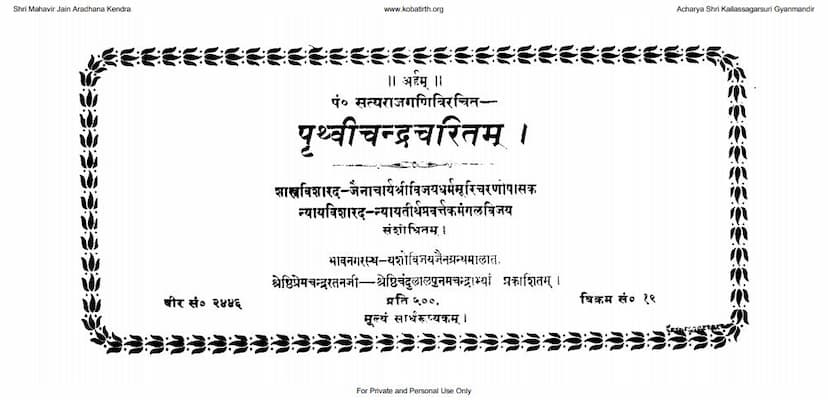Pruthvichandra Charitram
Added to library: September 2, 2025

Summary
Here's a comprehensive summary of the Jain text "Pruthvichandra Charitram," based on the provided pages:
Book Title: Pruthvichandra Charitram Author: Satyaraj Gani Revised by: Mangalvijay Publisher: Chandulal Punamchand Publication Year: 1920 (Vikram Samvat 1977)
Overview: "Pruthvichandra Charitram" is a Jain narrative attributed to the learned monk Pandit Satyaraj Gani, who lived in the 16th century of the Vikram era (specifically, he mentions completing a related work in Samvat 1514 and this work in Samvat 1535). The text was revised and published by Mangalvijay. It chronicles the life and spiritual journey of various individuals, highlighting Jain principles, virtues, and the consequences of actions (karma). The narrative unfolds through a series of "bhavas" or life episodes, illustrating how past actions influence present circumstances and future rebirths.
Key Themes and Content:
The "Pruthvichandra Charitram" is a collection of stories that illustrate the Jain path to liberation (moksha) through adherence to ethical conduct, detachment from worldly pleasures, and the practice of virtues. The text emphasizes:
- Past Lives and Karma: A central theme is the concept of rebirth and how actions in previous lives (bhavas) shape an individual's destiny, fortune, suffering, and spiritual progress in subsequent lives. The narrative traces the transmigration of souls through different forms and circumstances.
- Virtue and Vice: The stories consistently contrast virtuous actions (such as charity, truthfulness, non-violence, self-control, devotion to Jain principles) with vices (like greed, lust, anger, deceit, violence, attachment). The virtuous are rewarded with spiritual progress and heavenly births, while the vicious face suffering and hellish births.
- Detachment and Renunciation: The importance of detachment from worldly desires, material possessions, and sensual pleasures is a recurring motif. Characters who practice renunciation and asceticism are shown to progress towards liberation.
- The Path to Liberation (Moksha): The ultimate goal portrayed is liberation from the cycle of birth and death. This is achieved by following the teachings of the Tirthankaras, practicing the vows of Jainism, and cultivating inner purity.
- The Power of Knowledge and Spiritual Guidance: The narrative often features the role of learned monks (munis) and enlightened beings who impart spiritual wisdom and guidance, helping characters understand the consequences of their actions and the true path to happiness.
- Love and Relationships: While emphasizing detachment, the text also explores the complexities of relationships, familial bonds, and romantic attractions, often showing how these worldly attachments can be hindrances to spiritual progress if not managed with wisdom and detachment.
- Moral Instruction: The stories serve as moral lessons, aiming to inspire readers towards righteous living and deter them from sinful deeds.
Structure of the Narrative (through the Bhavas):
The text is divided into chapters ("bhavas") that detail different lifetimes or significant episodes in the lives of the characters. While a full synopsis of each character's journey is beyond a brief summary, the provided text indicates the following:
- First Bhava: Introduces Prince Pruthvichandra and his lineage. It details his marriage to Kalavati, the daughter of King Vijay. The narrative explores themes of love, duty, and the consequences of impulsive decisions, as well as the importance of past karma in shaping relationships. A significant part involves the story of the parrot from a previous life, explaining the amputation of Kalavati's arms.
- Second Bhava: Focuses on Prince Kamalaprasena, who later becomes the king. His story involves lessons on righteousness, compassion, and the dangers of materialism. It also touches upon the transmigration of souls and the influence of past lives.
- Third Bhava: Introduces Prince Devsimha and his spiritual inclination despite worldly allurements. It highlights the importance of following good company and the consequences of deviating from the righteous path.
- Fourth Bhava: Chronicles the lives of various characters, including Devaratha and Ratnavali, and explores themes of wealth, virtue, and the impact of past actions on marital bliss and progeny. The story of Vidhyadhara and his penance is also included.
- Fifth Bhava: Features Prince Purnachandra and his eventual attainment of spiritual knowledge. The narrative emphasizes the importance of righteousness in the face of worldly temptations and the guiding role of spiritual mentors.
- Sixth Bhava: Details the lives of King Narasingha and his son Surasena, focusing on their spiritual awakening and journey towards detachment from worldly pleasures. The influence of past lives and the importance of virtuous living are highlighted.
- Seventh Bhava: Follows Prince Padmottara and Harivega, their encounters with spiritual wisdom, and their eventual renunciation of worldly life. The story involves significant spiritual teachings from revered ascetics.
- Eighth Bhava: Centers on Prince Sribala and Shatabala, illustrating their virtues, the complexities of their relationships, and their eventual spiritual progression through adherence to Jain principles. The story of the cursed beings and their eventual liberation is also a key part.
- Ninth Bhava: Recounts the lives of Kankadhwaj and Jayasundara, their devotion to Jain principles, and their journey towards spiritual enlightenment. The narrative emphasizes the importance of integrity and the consequences of succumbing to temptations.
- Tenth Bhava: Focuses on Prince Kusumayudha and his spiritual enlightenment. The story highlights the importance of righteous conduct, detachment from worldly desires, and the pursuit of spiritual knowledge.
- Eleventh Bhava: This chapter details the life of Prince Pruthvichandra himself, tracing his journey from worldly entanglement to spiritual realization. It emphasizes the influence of past lives, the importance of spiritual guidance, and the ultimate attainment of omniscience (Kevala Jnana) and liberation. The text connects his life story with that of his previous births, illustrating the karmic threads binding his soul.
Significance:
The "Pruthvichandra Charitram" is a significant work in Jain literature, offering profound insights into Jain philosophy, ethics, and the path to salvation. It serves as a didactic text, guiding individuals towards a life of righteousness, virtue, and spiritual discipline, ultimately leading to the cessation of suffering and attainment of eternal bliss. The detailed narratives of past lives and the transformative power of virtuous actions make it a compelling and instructive read for followers of Jainism.